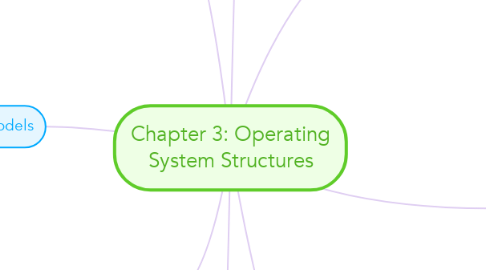
1. System Calls
1.1. provide the interface between a running program and the operating system
1.2. available as assembly-language instructions
1.3. Methods to pass parameters between a running program and the OS
1.3.1. Pass the parameters in registers
1.3.2. Parameters stored in a block, or table, in memory
1.3.3. address of block passed as a parameter in a register
1.4. Types of System Calls
1.4.1. Process control
1.4.2. File management
1.4.3. Device management
1.4.4. Information maintenance
1.4.5. Communications
1.4.6. Protection
2. Communication Models
2.1. message passing
2.2. shared memory
3. Layered Approach
3.1. the OS is divided into a number of layers (levels)
3.2. each built on top of lower layers. The bottom layer (layer 0)
3.3. the highest (layer N) is the user interface
3.4. Advantage
3.4.1. Simplicity of construction and debugging
3.5. Disadvantages
3.5.1. The careful definition and interaction of the layers
3.5.2. Less efficient
4. Operating System Design
4.1. Design and Implementation of OS not “solvable”, but some approaches have proven successful
4.2. The design of the system will be affected by the choice of hardware and the type of system
5. Operating System Services
5.1. User interface
5.2. Program execution
5.3. I/O operations
5.4. File-system manipulation
5.5. Communications
5.6. Error detection
6. Additional Operating System Functions
6.1. Resource allocation
6.2. Accounting
6.3. Protection and securit
7. Microkernel
7.1. Small operating system core
7.2. Contains only essential core operating systems functions
7.3. external subsystems
7.3.1. Device drivers
7.3.2. File systems
7.3.3. Virtual memory manager
7.3.4. Windowing system
7.3.5. Security services
7.4. Benefits
7.4.1. Extensibility
7.4.2. Flexibility
7.4.3. Reliability
7.4.4. Portability
8. Operating System Design Goals
8.1. User goals
8.1.1. operating system should be convenient to use, easy to learn, reliable, safe, and fast
8.2. System goals
8.2.1. operating system should be easy to design, implement, and maintain, as well as flexible, reliable, error-free, and efficient

